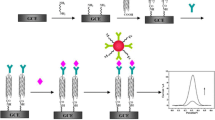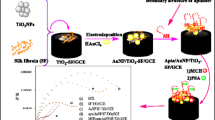Abstract
We report on a sensitive electrochemical aptasensor for the detection of human prostate specific antigen (PSA). It is based on the signal amplification of the biotin-avidin system using a sensing platform that is making use of a graphite electrode modified with gold nanoparticles that were covered with graphitized mesoporous carbon nanoparticles (AuNPs@GMCs). The AuNPs@GMCs hybrid was prepared by linking 1,6-hexanedithiol-functionalized GMCs and gold nanoparticles via Au-S groups. Then, streptavidin was immobilized on the electrode modified with the AuNPs@GMCs so to enlarge the amount of biotin-aptamer which led to enhanced detection sensitivity. If an PSA aptamer captures the target PSA on the electrode, the differential pulse voltammetric (DPV) signal of the hexacyanoferrate redox system decreases. Factors affecting the performance of the aptasensor were studied in detail. Under optimal conditions, the DPV signal changes could be used to quantitatively detect PSA in the concentration range from 0.25 to 200 ng mL−1, with a lowest limit of detection as small as 0.25 ng mL−1. The aptasensor is highly specific and displays acceptable precision, good stability and repeatability.






Similar content being viewed by others
References
Partin AW, Kattan MW, Subong ENP, Walsh PC, Wojno KJ, Oesterling JE, Scardino PT, Pearson JD (1997) Combination of prostate-specific antigen, clinical stage, and gleason score to predict pathological stage of localized prostate cancer. JAMA 277:1445–1451
Jemal A, Siegel R, Xu J, Ward E (2010) Cancer statistics, 2010 CA Cancer J Clin 60:277–300
Wu GH, Datar RH, Hansen KM, Thundat T, Cote RJ, Majumdar A (2001) Bioassay of prostate-specific antigen (PSA) using microcantilevers. Nat Biotechnol 19:856–860
Schröder FH, Hugosson J, Roobol MJ, Tammela TLJ, Ciatto S, Nelen V, Kwiatkowski M, Lujan M, Lilja H, Zappa M, Määttänen L, Bangma CH, Au G, Villers A, Rebillard X (2009) Screening and prostate-cancer mortality in a randomized European study. N Engl J Med 360:1320–1328
Healy DA, Hayes CJ, Leonard P, McKenna L, O’Kennedy R (2007) Biosensor developments: application to prostate-specific antigen detection. Trends Biotechnol 25:125–131
Oberpenning F, Hetzel S, Weining C, Brandt B, De Angelis G, Heinecke A, Lein M, Fornara P, Schmid HP, Hertle L, Semjonow A (2003) Semi-quantitative immunochromatographic test for prostate specific antigen in whole blood: tossing the coin to predict prostate cancer? Eur Urol 43:478–484
Acevedo B, Perera Y, Ruiz M, Rojas G, Benítez J, Ayala M, Gavilondo J (2002) Development and validation of a quantitative ELISA for the measurement of PSA concentration. J Clin Chim Acta 317:55–63
Graves HCB, Wehner N, Stamey TA (1992) Ultrasensitive radioimmunoassay of prostate -specific antigen. Clin Chem 38:735–742
Albrecht S, Brandl H, Steinke M, Freidt T (1994) Chemliuminescent enzyme immunoassay of prostate-specifIc antigen based on indoxyl phosphate substrate. Clin Chem 40:1970–1971
Li H, Wei Q, He J, Li T, Zhao YF, Cai YY, Du B, Qian ZY, Yang MH (2011) Electrochemical immunosensors for cancer biomarker with signal amplification based on ferrocene functionalized iron oxide nanoparticles. Biosens Bioelectron 26:3590–3595
Tuerk C, Gold L (1990) Systematic evolution of ligands by exponential enrichment: RNA ligands to bacteriophage T4 DNA polymerase. Science 249:505–510
Ellington AD, Szostak JW (1990) In vitro selection of RNA molecules that bind specific ligands. Nature 346:818–822
Fang XH, Tan WH (2010) Aptamers generated from cell-SELEX for molecular medicine: a chemical biology approach. Acc Chem Res 43:48–57
Lee JH, Yigit MV, Mazumdar D, Lu Y (2010) Molecular diagnostic and drug delivery agents based on aptamer-nanomaterial conjugates. Adv Drug Deliv Rev 62:592–605
Sheng LF, Ren JT, Miao YQ, Wang JH, Wang EK (2011) PVP-coated graphene oxide for selective determination of ochratoxin A via quenching fluorescence of free aptamer. Biosens Bioelectron 26:3494–3499
Bai LJ, Yuan R, Chai YQ, Zhuo Y, Yuan YL, Wang Y (2012) Simultaneous electrochemical detection of multiple analytes based on dual signal amplification of single-walled carbon nanotubes and multi-labeled graphene sheets. Biomaterials 33:1090–1096
Feng LY, Chen Y, Ren JS, Qu XG (2011) A graphene functionalized electrochemical aptasensor for selective label-free detection of cancer cells. Biomaterials 32:2930–2937
Du Y, Chen CG, Yin JY, Li BL, Zhou M, Dong SJ, Wang EK (2010) Solid-state probe based electrochemical aptasensor for cocaine: a potentially convenient, sensitive, repeatable, and integrated sensing platform for drugs. Anal Chem 82:1556–1563
Kuang H, Chen W, Xu D, Xu L, Zhu Y, Liu L, Chu H, Peng C, Xu C, Zhu S (2010) Fabricated aptamer-based electrochemical “signal-off” sensor of ochratoxin A. Biosens Bioelectron 26:710–716
Sun CH, Liu XP, Feng KJ, Jiang JH, Shen GL, Yu RQ (2010) An aptazyme-based electrochemical biosensor for the detection of adenosine. Anal Chim Acta 669:87–93
Savory N, Abe K, Sode K, Ikebukuro K (2010) Selection of DNA aptamer against prostate specific antigen using a genetic algorithm and application to sensing. Biosens Bioelectron 26:1386
Chen JR, Miao YQ, He NY, Wu XH, Li SJ (2004) Nanotechnology and biosensors. Biotechnol Adv 22:505–518
Yang WR, Ratinac KR, Ringer SP, Thordarson P, Gooding JJ, Braet F (2010) Carbon nanomaterials in biosensors: should you use nanotubes or graphene? Angew Chem Int Ed 49:2114–2138
Siwy ZS, Davenport M (2010) Biosensors: making nanopores from nanotubes. Nat Nanotechnol 5:174–175
Lawrence NS, Liang HP (2008) Metal nanoparticles: applications in electroanalysis. In: Eftekhari A (ed) Nanostructured materials in electrochemistry, 12th edn. Wiley, Germany, pp 435–457
Liang CD, Li ZJ, Dai S (2008) Mesoporous carbon materials: synthesis and modification. Angew Chem Int Ed 47:3696–3717
Lee J, Kim J, Hyeon T (2006) Recent progress in the synthesis of porous carbon materials. Adv Mater 18:2073–2094
Stein A, Wang Z, Fierke MA (2009) Functionalization of porous carbon materials with designed pore architecture. Adv Mater 21:265–293
Lu XB, Xiao Y, Lei ZB, Chen JP (2009) Graphitized macroporous carbon microarray with hierarchical mesopores as host for the fabrication of electrochemical biosensor. Biosens Bioelectron 25:244–247
Liu B, Lu LS, Li Q, Xie GM (2011) Disposable electrochemical immunosensor for myeloperoxidase based on the indium tin oxide electrode modified with an ionic liquid composite film containing gold nanoparticles, poly(o-phenylenediamine) and carbon nanotubes. Microchim Acta 173:513–520
Zhao J, Zhang YY, Li HT, Wen YQ, Fan XL, Lin FB, Tan L, Yao SZ (2011) Ultrasensitive electrochemical aptasensor for thrombin based on the amplification of aptamer-AuNPs-HRP conjugates. Biosens Bioelectron 26:2297–2303
Chuang YC, Li JC, Chen SH, Liu TY, Kuo CY, Huang WT, Lin CS (2010) An optical biosensing platform for proteinase activity using gold nanoparticles. Biomaterials 31:6087–6095
Chen Y, Li Y, Sun D, Tian DB, Zhang JR, Zhu JJ (2011) Fabrication of gold nanoparticles on bilayer graphene for glucose electrochemical biosensing. J Mater Chem 21:7604–7611
Frens G (1973) Controlled nucleation for the regulation of the particle size in monodisperse gold suspensions. Nat Phys Sci 241:20–22
Uludağ Y, Tothill IE (2010) Development of a sensitive detection method of cancer biomarkers in human serum (75 %) using a quartz crystal microbalance sensor and nanoparticles amplification system. Talanta 82:277–282
Xu SJ, Liu Y, Wang TH, Li JH (2011) Positive potential operation of a cathodic electrogenerated chemiluminescence immunosensor based on luminol and graphene for cancer biomarker detection. Anal Chem 83:3817–3823
Kim DJ, Lee NE, Park JS, Park IJ, Kim JG, Cho HJ (2010) Organic electrochemical transistor based immunosensor for prostate specific antigen (PSA) detection using gold nanoparticles for signal amplification. Biosens Bioelectron 25:2477–2482
Wei Q, Zhao YF, Xu CX, Wu D, Cai YY, He J, Li H, Du B, Yang MH (2011) Nanoporous gold film based immunosensor for label-free detection of cancer biomarker. Biosens Bioelectron 26:3714–3718
Chikkaveeraiah BV, Mani V, Patel V, Gutkind JS (2011) Microfluidic electrochemical immunoarray for ultrasensitive detection of two cancer biomarker proteins in serum. 26: 4477–4483
Mao KX, Wu D, Li Y, Ma HM, Ni ZZ, Yu HQ, Luo CN, Wei Q, Du B (2012) Label-free electrochemical immunosensor based on graphene/methylene blue nanocomposite. Anal Biochem 422:22–27
Yang MH, Javadi A, Li H, Gong SQ (2010) Ultrasensitive immunosensor for the detection of cancer biomarker based on graphene sheet. Biosens Bioelectron 26:560–565
Qu B, Guo L, Chu X, Wu DH, Shen GL, Yu RQ (2010) An electrochemical immunosensor based on enzyme-encapsulated liposomes and biocatalytic metal deposition. Anal Chim Acta 663:147–152
Acknowledgements
This work was supported by the Natural Science Foundation of China (81171415) and the Natural Science Foundation of Chongqing City (CSTC, 2010BB5356).
Author information
Authors and Affiliations
Corresponding author
Rights and permissions
About this article
Cite this article
Liu, B., Lu, L., Hua, E. et al. Detection of the human prostate-specific antigen using an aptasensor with gold nanoparticles encapsulated by graphitized mesoporous carbon. Microchim Acta 178, 163–170 (2012). https://doi.org/10.1007/s00604-012-0822-5
Received:
Accepted:
Published:
Issue Date:
DOI: https://doi.org/10.1007/s00604-012-0822-5




